Submitted:
03 June 2024
Posted:
04 June 2024
You are already at the latest version
Abstract
Keywords:
1. Introduction
2. Materials and Methods
2.1. Study Area
2.1. Spatial data used to evaluate LULC and classify native vegetation.
2.2. LULC classification attributes from integrated optical and SAR data
2.3. Image classification and accuracy assessment
3. Results
3.1. Detailed LULC Classification for Integrated SAR and Optical Data
3.2. LULC and accuracy assessment
4. Discussion
5. Conclusions
Author Contributions
Funding
Acknowledgments
Conflicts of Interest
References
- Akbari, M.; Neamatollahi, E.; Neamatollahi, P. Evaluating Land Suitability for Spatial Planning in Arid Regions of Eastern Iran Using Fuzzy Logic and Multi-Criteria Analysis. Ecol. Indic. 2019, 98, 587–598. [Google Scholar] [CrossRef]
- NEVES, G.L.; GUIMARÃES, T.T.; ANJINHO, P.S.; BARBOSA, M.A.G.A.; SANTOS, A.R. DOS; VIRGENS FILHO, J.S.; MAUAD, F.F. Spatial and Seasonal Assessment of Water Quality in the Lobo Stream River Basin, Brazil Using Multivariate Statistical Techniques. An. Acad. Bras. Cienc. 2021, 93. [Google Scholar] [CrossRef] [PubMed]
- da Anjinho, P.S.; Barbosa, M.A.G.A.; Costa, C.W.; Mauad, F.F. Environmental Fragility Analysis in Reservoir Drainage Basin Land Use Planning: A Brazilian Basin Case Study. Land use policy 2021, 100, 104946. [Google Scholar] [CrossRef]
- Santos, A.R.; Barbosa, M.A.G.A.; Bolleli, T.; Anjinho, P.S.; Roque, R.; Mauad, F.F. Assessment of Water Ecosystem Integrity (WEI) in a Transitional Brazilian Cerrado–Atlantic Forest Interface. Water 2023, 15, 775. [Google Scholar] [CrossRef]
- Souza, C.M.; Shimbo, J.Z.; Rosa, M.R.; Parente, L.L.; Alencar, A.A.; Rudorff, B.F.T.; Hasenack, H.; Matsumoto, M.; Ferreira, L.G.; Souza-Filho, P.W.M.; et al. Reconstructing Three Decades of Land Use and Land Cover Changes in Brazilian Biomes with Landsat Archive and Earth Engine. Remote Sens. 2020, 12, 2735. [Google Scholar] [CrossRef]
- Ustaoglu, E.; Aydınoglu, A.C. Suitability Evaluation of Urban Construction Land in Pendik District of Istanbul, Turkey. Land use policy 2020, 99, 104783. [Google Scholar] [CrossRef]
- DeFries, R.S.; Floey, J.A.; Asner, G.P. Land-Use Choices: Balancing Human Needs and Ecosystem Function. Front. Ecol. Environ. 2004, 2, 249–257. [Google Scholar] [CrossRef]
- Tundisi, J.G.; Matsumura-Tundisi, T. The Ecology of UHE Carlos Botelho (Lobo-Broa Reservoir) and Its Watershed, São Paulo, Brazil. Freshw. Rev. 2013, 6, 75–91. [Google Scholar] [CrossRef]
- Tundisi, J.G.; Tundisi, T.M. Integrating Ecohydrology, Water Management, and Watershed Economy: Case Studies from Brazil. Ecohydrol. Hydrobiol. 2016, 16, 83–91. [Google Scholar] [CrossRef]
- De Luca, G.; M. N. Silva, J.; Di Fazio, S.; Modica, G. Integrated Use of Sentinel-1 and Sentinel-2 Data and Open-Source Machine Learning Algorithms for Land Cover Mapping in a Mediterranean Region. 2022, 55, 52–70. [CrossRef]
- WWF, W.W.F.F.N. Cerrado, the Brazilian Savanna. Available online: https://wwf.panda.org/discover/knowledge_hub/where_we_work/cerrado/ (accessed on 19 September 2022).
- MapBiomas, C. Projeto MapBiomas – Mapeamento Anual de Cobertura e Uso Da Terra No Cerrado - Coleção 7; 2022.
- MapBiomas, M.A. Projeto MapBiomas – Mapeamento Anual de Cobertura e Uso Da Terra Na Mata Atlântica - Coleção 7; 2022.
- Santos, A.R. dos; Silva, R.C.F. da; Assis, L.C. de; Mauad, F.F. Defining Environmental Conservation Levels Considering Anthropic Activity in the Uberaba River Basin Protected Area. Ambient. e Agua - An Interdiscip. J. Appl. Sci. 2019, 14, 1. [Google Scholar] [CrossRef]
- Maxwell, A.E.; Warner, T.A.; Fang, F. Implementation of Machine-Learning Classification in Remote Sensing: An Applied Review. Int. J. Remote Sens. 2018, 39, 2784–2817. [Google Scholar] [CrossRef]
- Wen, D.; Ma, S.; Zhang, A.; Ke, X. Spatial Pattern Analysis of the Ecosystem Services in the Guangdong-Hong Kong-Macao Greater Bay Area Using Sentinel-1 and Sentinel-2 Imagery Based on Deep Learning Method. Sustain 2021, 13, 7044. [Google Scholar] [CrossRef]
- de Diniz, J.M.F.S.; Gama, F.F.; Adami, M. Evaluation of Polarimetry and Interferometry of Sentinel-1A SAR Data for Land Use and Land Cover of the Brazilian Amazon Region. Geocarto Int. 2020, 0, 1–19. [Google Scholar] [CrossRef]
- Eibedingil, I.G.; Gill, T.E.; Scott Van Pelt, R.; Tong, D.Q. Combining Optical and Radar Satellite Imagery to Investigate the Surface Properties and Evolution of the Lordsburg Playa, New Mexico, USA. Remote Sens. 2021, 13, 3402. [Google Scholar] [CrossRef]
- Ienco, D.; Interdonato, R.; Gaetano, R.; Ho Tong Minh, D. Combining Sentinel-1 and Sentinel-2 Satellite Image Time Series for Land Cover Mapping via a Multi-Source Deep Learning Architecture. ISPRS J. Photogramm. Remote Sens. 2019, 158, 11–22. [Google Scholar] [CrossRef]
- Morin, D.; Planells, M.; Guyon, D.; Villard, L.; Mermoz, S.; Bouvet, A.; Thevenon, H.; Dejoux, J.F.; Le Toan, T.; Dedieu, G. Estimation and Mapping of Forest Structure Parameters from Open Access Satellite Images: Development of a Generic Method with a Study Case on Coniferous Plantation. Remote Sens. 2019, 11, 1275. [Google Scholar] [CrossRef]
- Nikaein, T.; Iannini, L.; Molijn, R.A.; Lopez-Dekker, P. On the Value of Sentinel-1 InSAR Coherence Time-Series for Vegetation Classification. Remote Sens. 2021, 13, 3300. [Google Scholar] [CrossRef]
- Numbisi, F.N.; Van Coillie, F.M.B.; De Wulf, R.; Be, F.V.; Dewulf@ugent, R.; Be (, R.D.W. Delineation of Cocoa Agroforests Using Multiseason Sentinel-1 SAR Images: A Low Grey Level Range Reduces Uncertainties in GLCM Texture-Based Mapping. ISPRS Int. J. Geo-Information 2019, 8, 179. [Google Scholar] [CrossRef]
- Zhang, W.; Brandt, M.; Wang, Q.; Prishchepov, A. V.; Tucker, C.J.; Li, Y.; Lyu, H.; Fensholt, R. From Woody Cover to Woody Canopies: How Sentinel-1 and Sentinel-2 Data Advance the Mapping of Woody Plants in Savannas. Remote Sens. Environ. 2019, 234, 111465. [Google Scholar] [CrossRef]
- Fang, B.; Li, Y.; Zhang, H.; Chan, J.C.W. Collaborative Learning of Lightweight Convolutional Neural Network and Deep Clustering for Hyperspectral Image Semi-Supervised Classification with Limited Training Samples. ISPRS J. Photogramm. Remote Sens. 2020, 161, 164–178. [Google Scholar] [CrossRef]
- Campregher, R.; Martins, R.C. O “Modelo Broa” e a Produção de Conhecimento Científico Sobre o Meio Ambiente. Desenvolv. e Meio Ambient. 2017, 40, 141–158. [Google Scholar] [CrossRef]
- Santos, A.R. dos; Anjinho, P. da S.; Neves, G.L.; Barbosa, M.A.G.A.; de Assis, L.C.; Mauad, F.F. Dynamics of Environmental Conservation: Evaluating the Past for a Sustainable Future. Int. J. Appl. Earth Obs. Geoinf. 2021, 102, 102452. [Google Scholar] [CrossRef]
- São Paulo, G. do E. de Declara Área de Proteção Ambiental Regiões Situadas Em Diversos Municípios, Dentre Os Quais Corumbatai, Botucatu e Tejupa; Brasil, 1983.
- IF, I.F. do E. de S.P. Plano de Manejo Integrado Das Estações Ecológica e Experimetnal de Itirapina/SP; 2006.
- ESA, E.S.A. Copernicus Open Access Hub. Available online: https://scihub.copernicus.eu/dhus/#/home (accessed on 24 April 2023).
- United States Geological Survey, U. Digital Elevation Model (DEM), Advanced Spaceborne Thermal Emis-Sion and Reflec-Tion Radiometer (ASTER). Copernicus Open Access Hub Eur. Sp. Agency 2015. [Google Scholar]
- Mishra, V.N.; Prasad, R.; Rai, P.K.; Vishwakarma, A.K.; Arora, A. Performance Evaluation of Textural Features in Improving Land Use/Land Cover Classification Accuracy of Heterogeneous Landscape Using Multi-Sensor Remote Sensing Data. Earth Sci. Informatics 2019, 12, 71–86. [Google Scholar] [CrossRef] [PubMed]
- Varghese, A.O.; Suryavanshi, A.; Joshi, A.K. Analysis of Different Polarimetric Target Decomposition Methods in Forest Density Classification Using C Band SAR Data. 2016, 37, 694–709. [CrossRef]
- Cloude, S. The Dual Polarization Entropy/Alpha Decomposition: A PALSAR Case Study. ESASP 2007, 644, 2. [Google Scholar]
- Lee, J. Sen Digital Image Enhancement and Noise Filtering by Use of Local Statistics. IEEE Trans. Pattern Anal. Mach. Intell. 1980; PAMI-2, 165–168. [Google Scholar] [CrossRef]
- Belgiu, M.; Drăgu, L. Random Forest in Remote Sensing: A Review of Applications and Future Directions. ISPRS J. Photogramm. Remote Sens. 2016, 114, 24–31. [Google Scholar] [CrossRef]
- Breiman, L. Random Forests. Mach. Learn. 2001, 45, 5–32. [Google Scholar] [CrossRef]
- Foody, G.M. Status of Land Cover Classification Accuracy Assessment. Remote Sens. Environ. 2002, 80, 185–201. [Google Scholar] [CrossRef]
- Foody, G.M. Explaining the Unsuitability of the Kappa Coefficient in the Assessment and Comparison of the Accuracy of Thematic Maps Obtained by Image Classification. Remote Sens. Environ. 2020, 239, 111630. [Google Scholar] [CrossRef]
- Story, M.; Congalton, R.G. Accuracy Assessment: A User’s Perspective. Photogramm. Eng. Remote Sensing 1986, 52, 397–399. [Google Scholar]
- Heidarlou, H.B.; Shafiei, A.B.; Erfanian, M.; Tayyebi, A.; Alijanpour, A. Effects of Preservation Policy on Land Use Changes in Iranian Northern Zagros Forests. Land use policy 2019, 81, 76–90. [Google Scholar] [CrossRef]
- Calijuri, M.L.; de Castro, J.S.; Costa, L.S.; Assemany, P.P.; Alves, J.E.M. Impact of Land Use/Land Cover Changes on Water Quality and Hydrological Behavior of an Agricultural Subwatershed. Environ. Earth Sci. 2015, 74, 5373–5382. [Google Scholar] [CrossRef]
- Mishra, P.K.; Rai, A.; Rai, S.C. Land Use and Land Cover Change Detection Using Geospatial Techniques in the Sikkim Himalaya, India. Egypt. J. Remote Sens. Sp. Sci. 2020, 23, 133–143. [Google Scholar] [CrossRef]
- Periotto, N.A.; Tundisi, J.G. Serviĉos Ecossistêmicos Do Reservatório Da UHE Carlos Botelho (Lobo-Broa): Uma Nova Abordagem Para o Gerenciamento e Planejamento Dos Múltiplos Usos de Represas. Brazilian J. Biol. 2013, 73, 471–482. [Google Scholar] [CrossRef] [PubMed]
- Li, Z.; Chen, H.; White, J.C.; Wulder, M.A.; Hermosilla, T. Discriminating Treed and Non-Treed Wetlands in Boreal Ecosystems Using Time Series Sentinel-1 Data. Int. J. Appl. Earth Obs. Geoinf. 2020, 85, 102007. [Google Scholar] [CrossRef]
- Freeman, A.; Durden, S.L. A Three-Component Scattering Model for Polarimetric SAR Data. IEEE Trans. Geosci. Remote Sens. 1998, 36, 963–973. [Google Scholar] [CrossRef]
- Mishra, V.N.; Prasad, R.; Kumar, P.; Srivastava, P.K.; Rai, P.K. Knowledge-Based Decision Tree Approach for Mapping Spatial Distribution of Rice Crop Using C-Band Synthetic Aperture Radar-Derived Information. J. Appl. Remote Sens. 2017, 11, 1. [Google Scholar] [CrossRef]
- Delgado-Aguilar, M.J.; Fassnacht, F.E.; Peralvo, M.; Gross, C.P.; Schmitt, C.B. Potential of TerraSAR-X and Sentinel 1 Imagery to Map Deforested Areas and Derive Degradation Status in Complex Rain Forests of Ecuador. Int. For. Rev. 2017, 19, 102–118. [Google Scholar] [CrossRef]
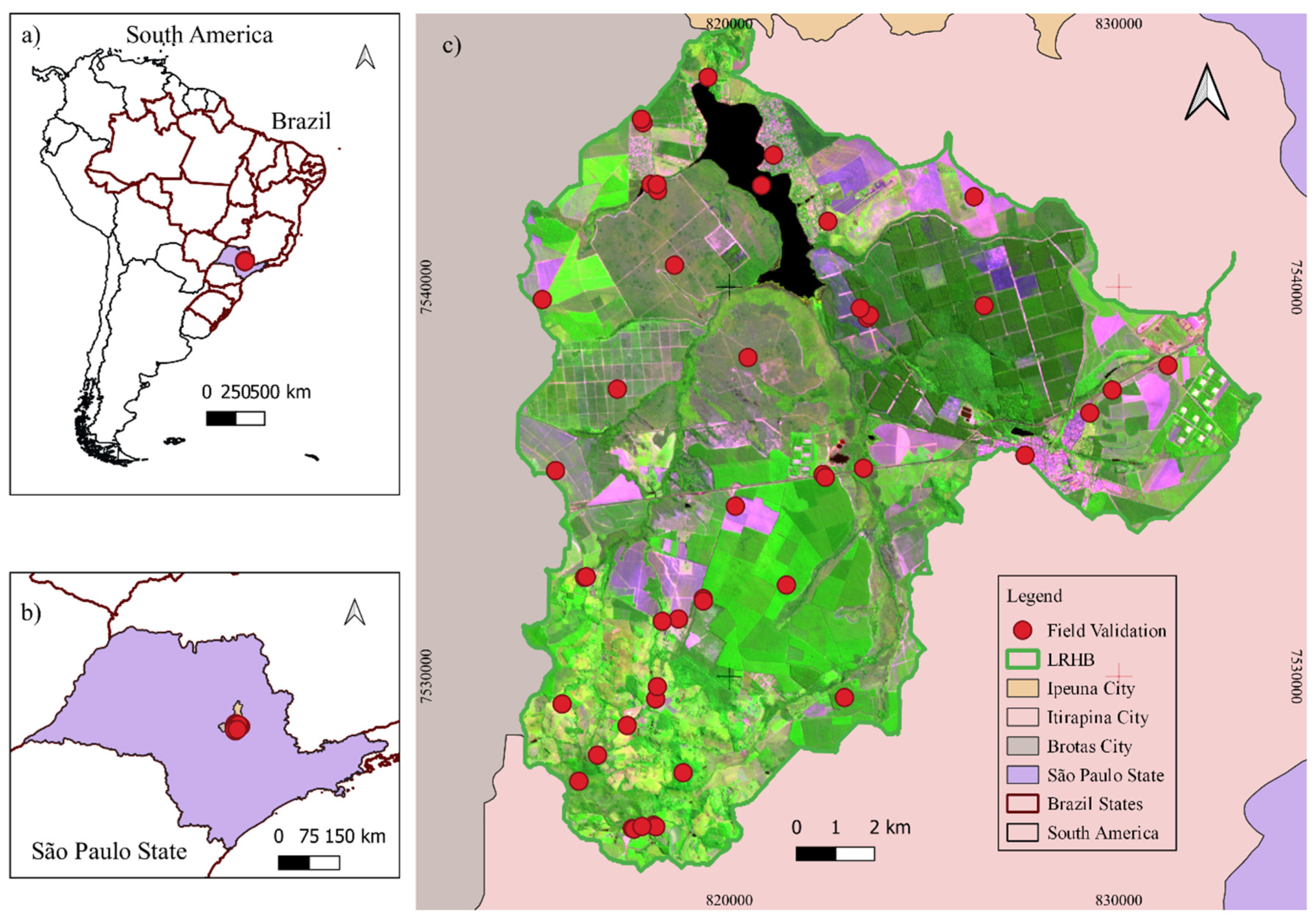
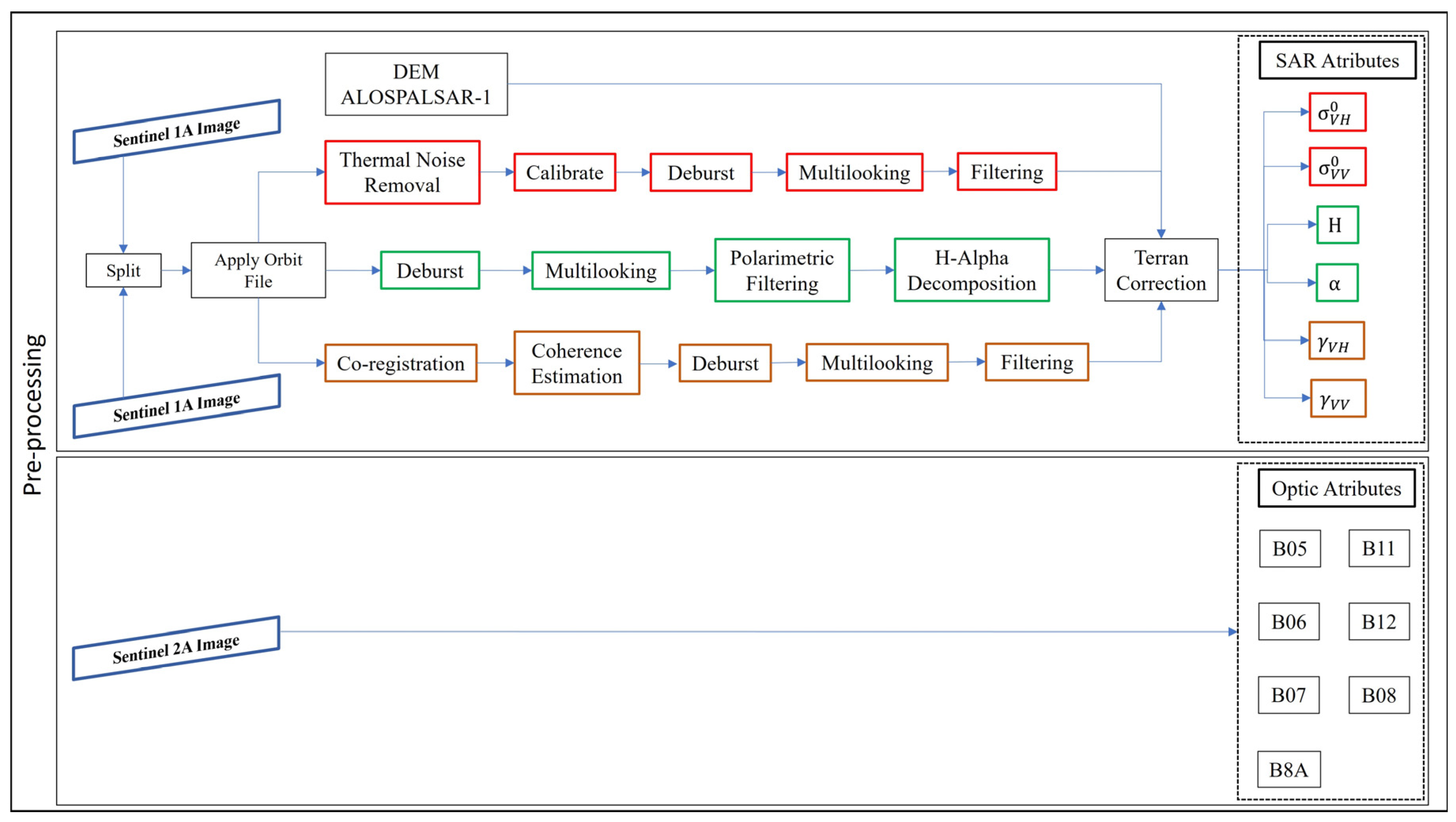
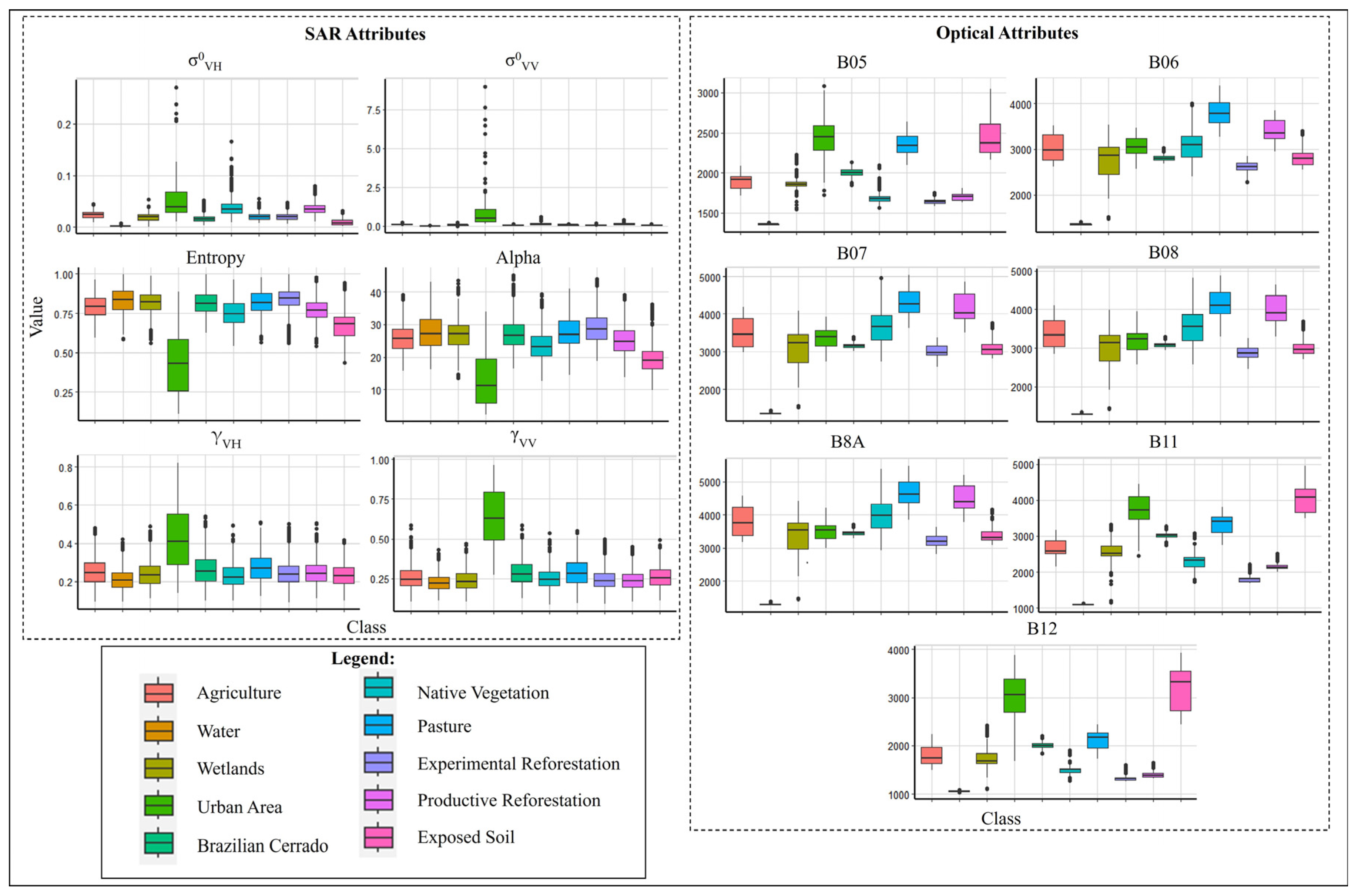
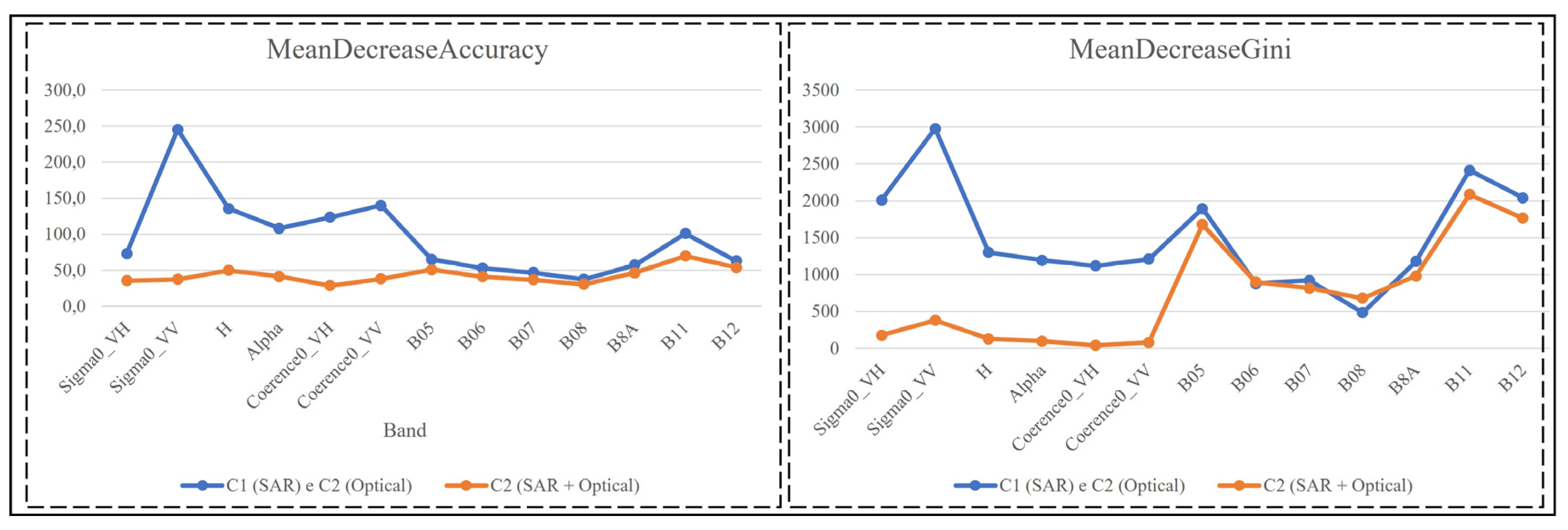
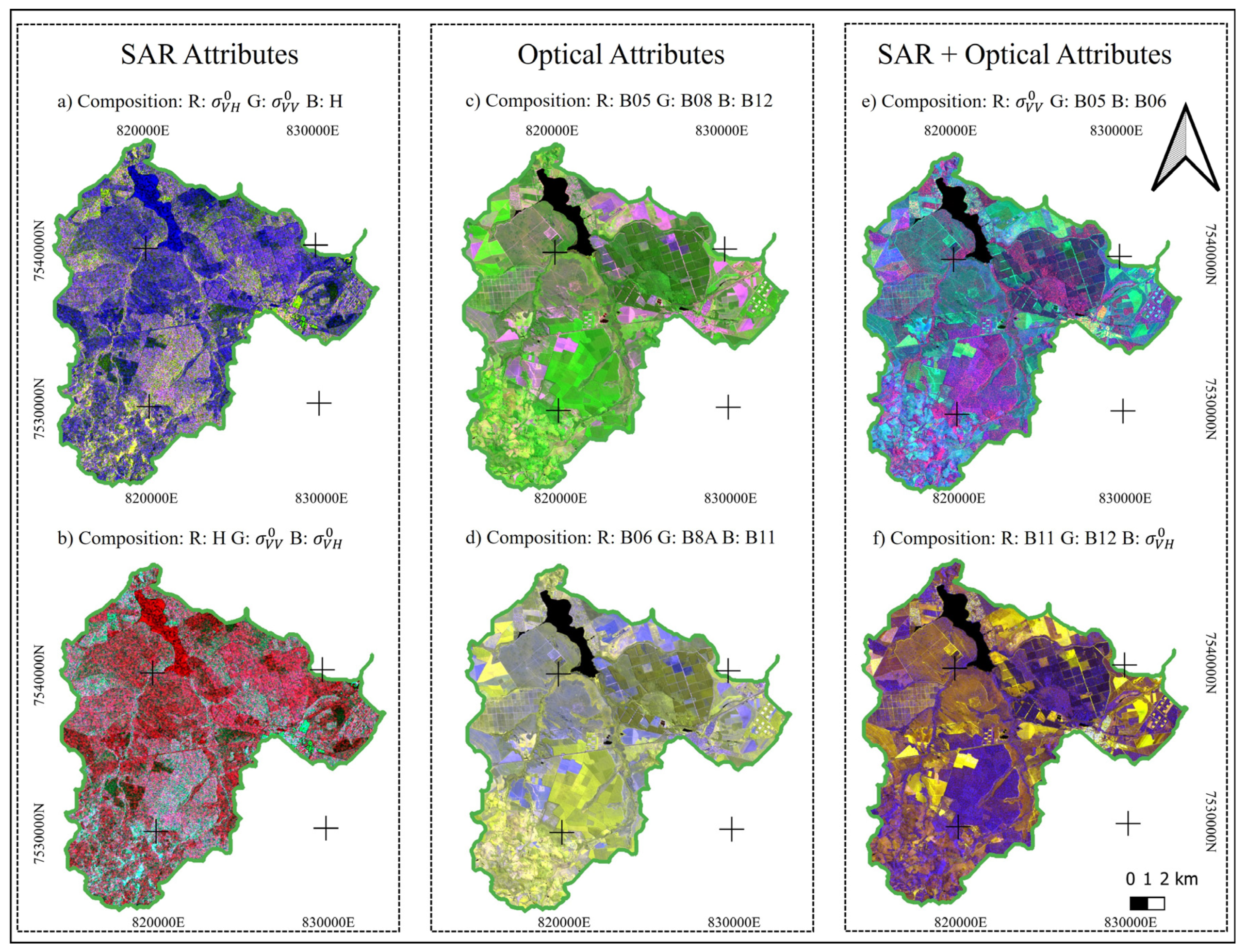
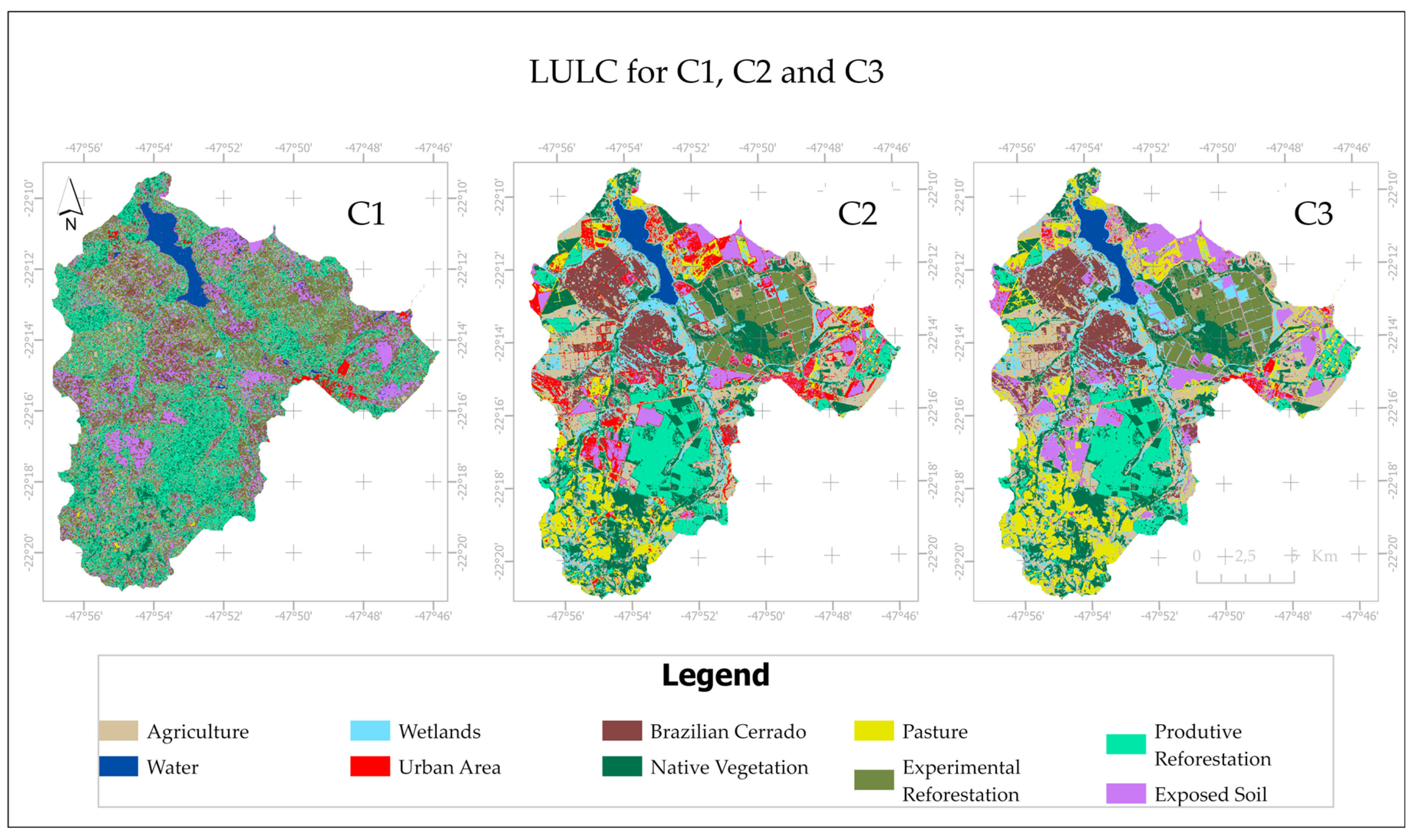
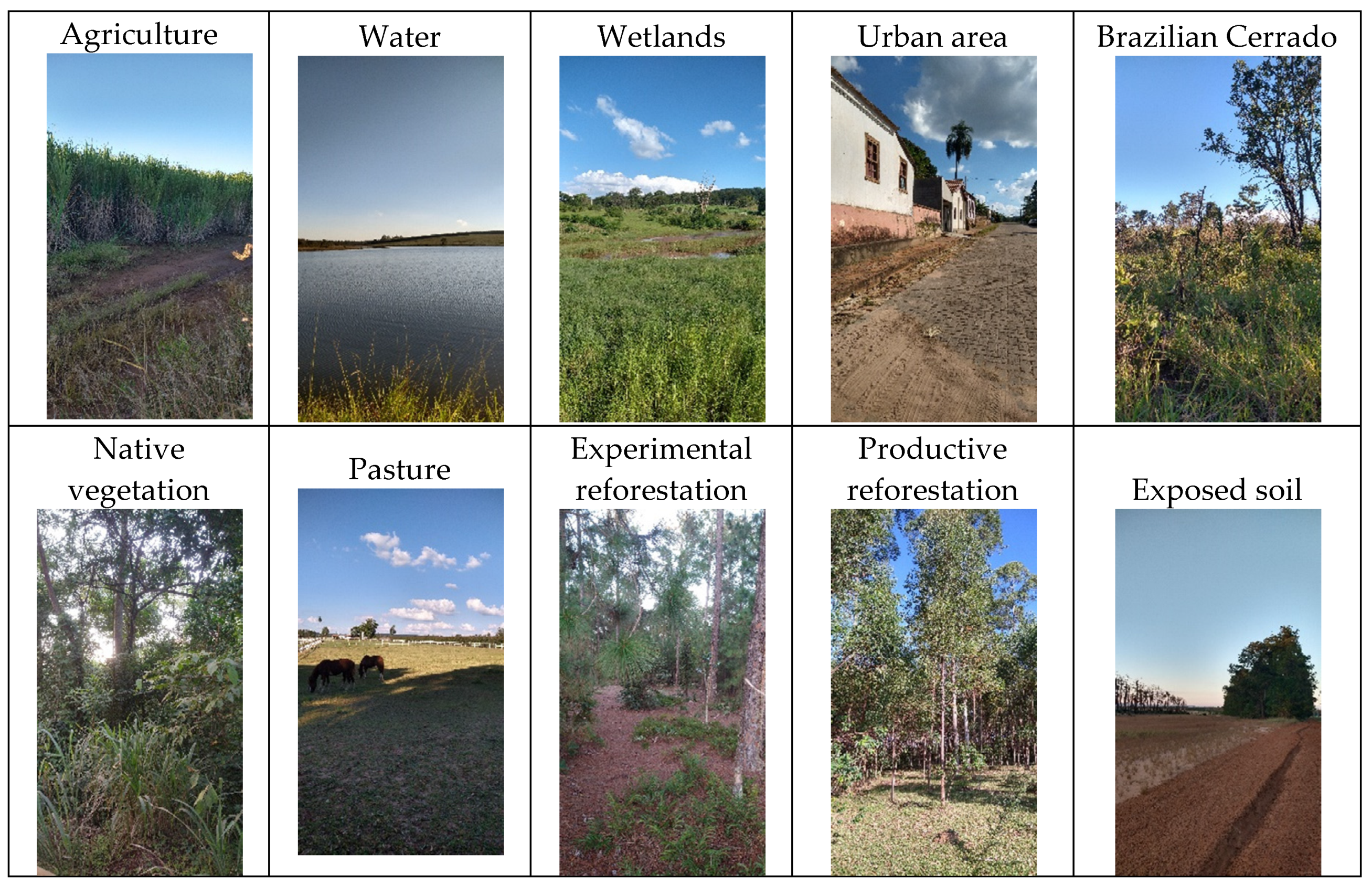
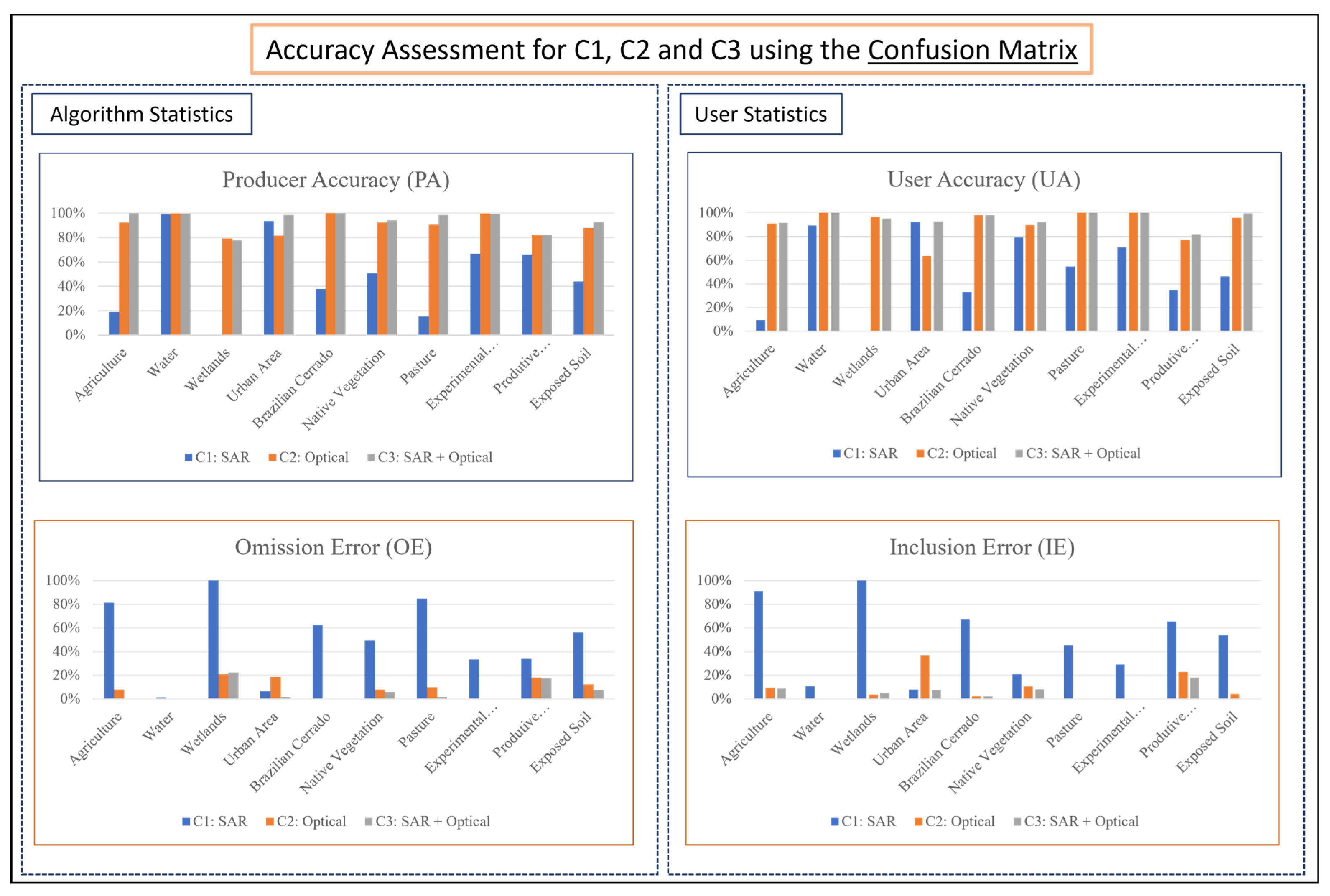
| Data | Source | Acquired | Acquisition | Resolution |
|---|---|---|---|---|
| LULC | Sentinel 1 image | 12/19/2022 | [29] | 5 x 20 m |
| 12/31/2022 | ||||
| Sentinel 2 image | 3/25/2023 | [29] | 20 m | |
| Waterways | Digital Elevation Model, Advanced Spaceborne Thermal Emission and Reflection Radiometer | 2015 | [30] | 1:50.000 |
| LRHB contour |
| Set | Attributes | Data type |
|---|---|---|
| C1 | σ0VH + σ0VV + H + α + | SAR |
| C2 | B05 + B06 + B07 + B08 + B8A + B11 + B12 | Optical |
| C3 | σ0VH + σ0VV + H + α + + B05 + B06 + B07 + B08 + B8A + B11 + B12 |
Combined |
Disclaimer/Publisher’s Note: The statements, opinions and data contained in all publications are solely those of the individual author(s) and contributor(s) and not of MDPI and/or the editor(s). MDPI and/or the editor(s) disclaim responsibility for any injury to people or property resulting from any ideas, methods, instructions or products referred to in the content. |
© 2024 by the authors. Licensee MDPI, Basel, Switzerland. This article is an open access article distributed under the terms and conditions of the Creative Commons Attribution (CC BY) license (http://creativecommons.org/licenses/by/4.0/).





